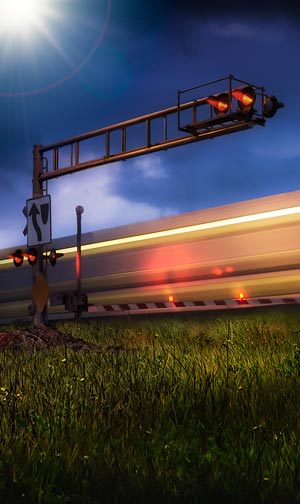Union Pacific Collision in Kansas Had All the Potential Elements of the Canadian Catastrophe
(Hayes, Kansas – July 16, 2013)
Another example of why the National Transportation Safety Board included the activation of a nationwide, satellite-based, Positive Train Control system to prevent collisions between trains carrying either passengers or hazardous materials through overriding the failure of train crews to properly and safely control their trains as number one on the agency’s “Wish List” for transportation safety improvement in 2013 was played out early Tuesday morning. A Denver-bound Union Pacific train with a crew of three collided with an unoccupied, standing UPRR freight train on the same set of railroad tracks near the busy intersection of 8th and Vine Streets in Hayes, KS at about 1:25 A.M., derailing three locomotives and at least a dozen cars of the 79-car train. The derailment caused evacuations, road closures and ignited a fire that produced flames that could be seen for miles.
The potential for a disaster of the proportions of the Lec-Megantic, Quebec, Canada catastrophe was possible because of the 79-car train, there were 20 huge tank cars carrying thousands of gallons of low-grade ethanol fuel. Whether the tank cars on the UPRR train were DOT-111 tank cars, known to be extremely vulnerable to coupler override and shell puncture, as was the case in the Canadian disaster, was not known. What was known was that the locomotives’ fuel tanks were each nearly full of their 3,000-gallon diesel fuel capacities since the train had originated in Salina, KS, only 100 miles east of Hayes.
At least 20 people were evacuated as a precautionary action from a mobile home park in the vicinity of the intersection, and a shelter had been set up at Holy Family School for the displaced families and individuals. Traffic was being rerouted and the flames from the diesel fuel were still burning at 8:00 A.M. as emergency responders from seven fire departments and public safety agencies battled the fires and directed both the public and railroad officials away from the collision site.
Residents of Hayes were being asked to conserve water, as firefighters were pouring an estimated 5,000 gallons of water a minute on the inferno. Fortunately, no injuries to residents, responders, or railroad employees had been reported thus far. Miraculously, none of the ethanol-carrying tankers derailed.
A week ago Saturday, the derailment and explosion of several DOT-111 tank cars loaded with crude oil being transported from the North Dakota oil fields to a refinery in New Brunswick, Canada aboard a Montreal, Maine & Atlantic train, occurred when part of the train rolled down a seven mile hill and came off the rails in the heart of the tourist-laden community of Lec-Megantic, QU. Causing at least 50 deaths among residents and visitors of the picturesque lake community.
American railroads have fought the institution of PTC on US rails, currently planned for a 2015 launch. The railroads have asked instead for an additional five-year delay to activation of the system, which could have prevented Tuesday’s tragedy.


